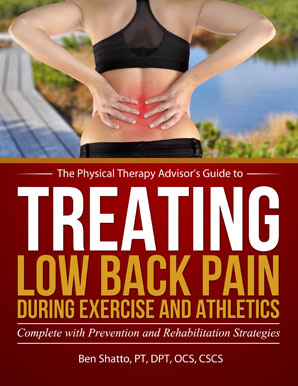“When can I return to my normal activity after experiencing an episode of severe low back or sciatic pain?” is a question I am often asked as a physical therapist. Low back pain (LBP) and sciatic pain can be so severe and debilitating that it can completely derailing your training and lifestyle! It’s hard to run, exercise or even move if your back, buttocks or leg hurts.
Believe it or not, in spite of what your back or sciatic pain is telling you, initial activity and exercise are a critical component to treatment and recovery and is backed by extensive scientific research.

Everyone’s experience with low back or sciatic pain is different. The severity of pain can widely vary. For some, even walking normally can be difficult. A guide for which exercises and movements to perform is critical in order to successfully return to activity.
One crucial indicator that you’re ready to taper back into more regular activity (as you progress your rehabilitation-based exercise) is whether or not you can walk with a normal gait. In particular, can you walk normally with a longer stride length during your normal gait cycle?
The ability to walk normally (notice that I didn’t say without discomfort) is an important milestone. It means that the spine is being stabilized well enough from the core musculature and that the nerves in the leg are not too tight or inflamed to tolerate and accommodate for the stretch that will occur from other activities.
If you are unable to walk normally, then the emphasis should be on regaining lumbar and lower extremity range of motion in addition to performing core and lumbar stabilization exercises. Limit your sitting, but do not try to taper back into other activities (at least not yet).
It’s critical to remember that everyone’s recovery will be different. Recovery and tapering back into your normal activities should be entirely symptom dependent. Listen to your body on what it can handle. The pain will tell you if you need to stop.
When to Return to Exercise after having Low Back or Sciatic Pain:
Follow the rule of thumb for movement: If the pain worsens by spreading peripherally down the buttock and into the leg and/or foot, then the condition is worsening. You must stop that activity. If the pain centralizes and returns back toward the spine (even if the pain worsens slightly), then keep moving as the condition is actually improving.
- Don’t resume your running, jogging or other training activities until you can walk normally at a quick pace.
- Be sure to slowly taper back into your training as your back begins to feel better. Don’t quickly resume your prior training volume. Instead, taper back up.
- Prior to activity and training, perform a very thorough warm up (including press-ups, superman exercises, and bridging). Then transition into an activity specific warm up.
- Continue with a core and lumbar strengthening program at least until you resume your full volume of training.
Prior to returning to your full and normal training activities, insure the following:
- Complete lumbar mobility has returned.
- You no longer have sensations, weakness or instability within the spine.
- If you experienced leg pain, your involved leg is as flexible as the other. The pain is now either gone or centralized (meaning that you’re not experiencing pain in the leg).
- Your hip mobility on both sides is equal.
- Your involved leg is as strong as the other leg, particularly hip abduction (glutes medius) and the hip external rotators. Test this by jumping up and down on one leg. Do you feel strong? Is there pain associated with this? If the strength isn’t there or the pain remains, you are not ready to taper up to full training activities.
- You can jog, run, sprint, and jump without pain.
With proper treatment, low back or sciatic pain should resolve in as quickly as two weeks. Severe episodes can take 4-6 weeks or longer. Continue with your rehabilitation protocol until you’re performing all exercises normally.
Treatment for back or sciatic pain doesn’t have to include addicting medications, scary injections, surgery or high medical bills. For the approximate price of just one co-pay to see a doctor, you will receive my easy to read book with step-by-step instructions and a complete video package designed to help you prevent and self-treat reoccurring low back pain episodes.
The Treating Low Back Pain (LBP) during Exercise and Athletics Book and Video Package includes:

AVAILABLE NOW ON AMAZON!
Treating Low Back Pain during Exercise and Athletics eBook
In this eBook, you’ll learn why it is critically important to prevent the first episode of low back pain. LBP has reoccurrence rates as high as 90%. If you have already experienced an episode of LBP, you’ll learn why exercise is an important component to long term management. Most importantly, you will understand how to avoid pain and injury in order to take your training to the next level. Topics include:
- Specific strategies for LBP prevention.
- How to address specific causes of LBP.
- Best practices on how to prevent and self-treat when you experience an episode of LBP.
- A step-by-step LBP rehabilitation guide complete with photos and detailed exercise descriptions.
- How to implement prevention and rehabilitation strategies.
7-part Series of Instructional Videos
Nearly 60 minutes of actionable advice to prevent and treat LBP as it relates to active individuals, sports, and athletics. An in-depth look at treating LBP with a 7-part series of instructional videos in which I address the following:
- Potential Risk Factors for Lower Back Pain
- What are the Core Muscles?
- Prevention during Exercise (Part 1 and 2)
- Initial Treatment
- Further Treatment and Taping
- Long Term Management Strategies and Final Recap
Save 15% with discount code LBP
“As a long time back pain sufferer I can honestly say I’ve tried it all. True LBP will make you desperate enough to try anything. Long story short – Ben Shatto truly rescued me from this vicious pain cycle. Ben’s methods of physical therapy whether it’s hands on treatment or this amazing video packet, his methods prove to be cutting edge and highly effective. Healing takes work and this video package is a fantastic foundation for the healing process to ignite!” –Sandy
